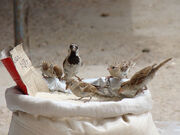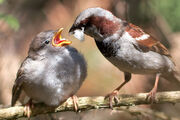mNo edit summary |
m (→External links) |
||
| Line 78: | Line 78: | ||
{{Passeridae}} |
{{Passeridae}} |
||
| + | |||
| + | {{Project Bird Genera}} |
||
[[Category:Passeridae]] |
[[Category:Passeridae]] |
||
[[Category:Passer|*]] |
[[Category:Passer|*]] |
||
Revision as of 23:11, 25 November 2011
| Passer | |
|---|---|

| |
| Male Cape Sparrows in Namibia | |
| Scientific classification | |
| Kingdom: | Animalia |
| Phylum: | Chordata |
| Class: | Aves |
| Order: | Passeriformes |
| Suborder: | Passeri |
| Infraorder: | Passerida |
| Superfamily: | Passeroidea |
| Family: | Passeridae |
| Genus: | Passer |
| Species | |
|
See text. | |
| Synonyms | |
|
Pyrtiga Cuvier, 1817 | |
Passer is a genus of Old World sparrows. These sparrows are plump little brown or greyish birds often with black, yellow or white markings. Typically 10–20 cm (4–8 in) long, they have short tails and stubby conical beaks. They are gregarious and will form substantial flocks, and some, though not the House Sparrow, have pleasant songs.[1]
Most of its members are found naturally in open habitats in the warmer climates of Africa and southern Eurasia. According to a molecular study published in 2001, the genus originated in Africa and Cape Sparrow is the most basal lineage.[2] Several species have adapted to human habitation, and this has enabled the House Sparrow in particular, in close association with humans, to extend its Eurasian range well beyond what was probably its original home in the Middle East.[3] Apart from this natural colonisation, the House Sparrow has been introduced to many parts of the world outside its natural range, including the Americas, sub-Saharan Africa, and Australia. The Eurasian Tree Sparrow has also been artificially introduced on a smaller scale, with populations in Australia and locally in Missouri and Illinois in the United States.[3]
Passer sparrows build an untidy nest, which, depending on species and nest site availability, may be in a bush or tree, a natural hole in a tree, in a building or in thatch, or in the fabric of the nest of species such as the White Stork. The clutch of up to eight eggs is incubated by both parents typically for 12–14 days, with another 14–24 more days to fledging.[4]
Passer sparrows are primarily ground-feeding seed-eaters, though they also consume small insects especially when breeding. A few species, like the House Sparrow and Northern Grey-headed Sparrow scavenge for food around cities, and are almost omnivorous.[5]
Species list

A mixed group of Passer sparrows containing a Eurasian Tree Sparrow, a male House Sparrow, and female House or Spanish Sparrows, feeding on grain in the town of Baikonur, Kazakhstan

A male House Sparrow feeding a fledgeling
These are the species recognised by the Handbook of the Birds of the World,[6] except for the Abd al-Kuri Sparrow, the split of which from the Socotra Sparrow was recognised by BirdLife International in 2010.[7] Besides these living species, some questionable fossils as early as the Early Miocene are known,[8] and the Middle Pleistocene fossil species Passer predomesticus.
- Saxaul Sparrow, Passer ammodendri
- House Sparrow, Passer domesticus
- Italian Sparrow, Passer italiae
- Spanish Sparrow, Passer hispaniolensis
- Sind Sparrow, Passer pyrrhonotus
- Somali Sparrow, Passer castanopterus
- Russet Sparrow or Cinnamon Sparrow, Passer rutilans
- Plain-backed Sparrow or Pegu Sparrow, Passer flaveolus
- Dead Sea Sparrow, Passer moabiticus
- Iago Sparrow or Cape Verde Sparrow, Passer iagoensis
- Great Sparrow, Passer motitensis
- Kenya Sparrow, Passer rufocinctus
- Kordofan Sparrow, Passer cordofanicus
- Shelley's Sparrow, Passer shelleyi
- Socotra Sparrow, Passer insularis
- Abd al-Kuri Sparrow, Passer hemileucus
- Cape Sparrow or Mossie, Passer melanurus
- Northern Grey-headed Sparrow, Passer griseus
- Swainson's Sparrow, Passer swainsonii
- Parrot-billed Sparrow, Passer gongonensis
- Swahili Sparrow, Passer suahelicus
- Southern Grey-headed Sparrow, Passer diffusus
- Desert Sparrow, Passer simplex
- Eurasian Tree Sparrow, Passer montanus
- Sudan Golden Sparrow, Passer luteus
- Arabian Golden Sparrow, Passer euchlorus
- Chestnut Sparrow, Passer eminibey
References
- ^ Clement, Harris & Davis 1993, p. 442
- ^ Allende, Luise M.; Rubio, Isabel; Ruiz del Valle, Valentin; Guillén, Jesus; Martínez-Laso, Jorge; Lowy, Ernesto; Varela, Pilar; Zamora, Jorge; Arnaiz-Villena, Antonio (2001). "The Old World Sparrows (Genus Passer) Phylogeography and their Relative Abundance of Nuclear mtDNA Pseudogenes". Journal of Molecular Evolution. 53: 144–154. PMID 11479685. doi:10.1007/s002390010202.
- ^ a b Summers-Smith, J. D. (1990). "Changes in distribution and habitat utilisation by members of the genus Passer". In Pinowski, J.; and Summers-Smith, J. D. Granivorous birds in the agricultural landscape. Warszawa: Pánstwowe Wydawnictom Naukowe. pp. 11–29. ISBN 83-01-08460-X.
- ^ Groschupf, Kathleen (2001). "Old World Sparrows". In Elphick, Chris; Dunning, Jr., John B.; Sibley, David. The Sibley Guide to Bird Life and Behaviour. London: Christopher Helm. pp. 562–564. ISBN 0-7136-6250-6.
- ^ Summers-Smith 1988, pp. 253–255
- ^ Summers-Smith, J. Denis (2009). "Family Passeridae (Old World Sparrows)". In del Hoyo, Josep; Elliott, Andrew; Christie, David. Handbook of the Birds of the World. Volume 14: Bush-shrikes to Old World Sparrows. Barcelona: Lynx Edicions. ISBN 978-84-96553-50-7.
- ^ BirdLife International (2010). "Species factsheet: Passer hemileucus". Retrieved 24 June 2010.
- ^ Mlíkovský 2002, p. 247
- Works cited
- Clement, Peter; Harris, Alan; Davis, John (1993). Finches and Sparrows: an Identification Guide. Princeton, New Jersey: Princeton University Press. ISBN 0-691-03424-9.
- Mlíkovský, Jiří (2002). Cenozoic Birds of the World, Part 1: Europe. Ninox Press. ISBN 80-901105-3-8 Check
|isbn=value: checksum (help). Archived from the original (PDF) on 6 March 2011. - Summers-Smith, J. Denis (1988). The Sparrows: a study of the genus Passer. illustrated by Robert Gillmor. Calton, Staffs, England: T. & A. D. Poyser. ISBN 0-85661-048-8.
External links
| Wikimedia Commons has media related to: http://commons.wikimedia.org/wiki/Passer |
- Passeridae on the Internet Bird Collection
| |||||||||||||||||||||||||||||||||||||||||||||||||||||||||||||||||||||||||||||||||

|
This article is part of Project Bird Genera, a All Birds project that aims to write comprehensive articles on each genus, including made-up genera. |
